Governance Combustion Engine
When authorities break their own environmental laws
Nitrogen oxide (NOx) emissions are created in hot, high-pressure, oxygen-rich environments. Court 76 at the Royal Courts of Justice in London was certainly hot and high-pressure this week, albeit less oxygen-rich by the end of each session. Yes, the long-awaited “Dieselgate” group litigation case has kicked off in the UK, only ten years and 25 days since the scandal originally broke in connection with Volkswagen in the US. The case and damages may take a year to resolve, keeping the near-fifty lawyers in the room and others well serried and occupied. Notable by its absence is Volkswagen itself, though it casts a long shadow.
The case will hinge on whether a large number of manufacturers installed prohibited defeat devices in their vehicles to spot that they were underdoing a certification test and switch to a “cleaner” mode than used in normal driving conditions. There are many, nuanced, arguments on both sides. This may not, however, be the most interesting aspect of this case. That so many lawyers can be working for so long untangling the truth originally springs from a simple failure: a poorly and ambiguously written legal regulation. A legislative failure. Compounding this, in practice there was no routine surveillance to check that NOx emissions were actually low, and there was also no enforcement. Governmental failures. More troubling still, several authorities were aware of real-world NOx exceedances (4.5 times the limit according to Emissions Analytics’ independent testing, which had been published) and decided to do nothing about it, until they were forced to by the fall-out from Volkswagen being prosecuted in September 2015. Therefore, for at least five years, governments were happy for their own laws to be broken.
Sadly, this case is more commonplace than one would hope and expect. In fact, it is emblematic of a failed mode of regulation, government and enforcement that has become all too normal. We are not here talking about where an industrial company illegally dumps waste into a river and is then prosecuted by the competent authority. Rather, it is about governments enacting environmental laws or regulations that they then go on not to meet themselves. It is only because most offences are not criminal ones, or that public office comes with certain immunities, that many government ministers are not in jail.
For more than a decade, the UK government persistently breached its own legally binding air quality limits for nitrogen dioxide (NO2), in violation of both domestic and retained EU law. Under the EU Ambient Air Quality Directive 2008/50/EC, the government was required to ensure that NO2 concentrations did not exceed annual and hourly limit values after 2010. Yet successive administrations failed to meet these limits across dozens of urban zones, particularly in London, Birmingham and other major cities. The courts repeatedly confirmed this illegality: in landmark cases brought by Client Earth (2015, 2016 and 2018), the Supreme Court and High Court ruled that ministers had acted unlawfully by approving inadequate air quality plans and not delivering compliance “as soon as possible.” Despite judicial orders, updated plans again fell short of statutory duties under the Environment Act (1995) and the Directive, revealing a pattern of systemic non-compliance and policy inertia that left the UK in continuous breach of its own air pollution laws for much of the 2010s.
Also in the UK, the Environment Agency has repeatedly failed to monitor England’s rivers and groundwater for many emerging pollutants of concern, despite its statutory duty under the Water Framework Regulations (2017) to maintain comprehensive surveillance of water quality. While the Agency is legally required to track priority and specific pollutants to assess chemical and ecological status, its monitoring network has declined sharply over the past decade, with most sites now tested for only a fraction of relevant contaminants. Substances such as PFAS, pharmaceuticals, microplastics, and other persistent organic chemicals – widely recognised by scientists and regulators as major environmental and health threats – remain largely untested or are monitored only through limited pilot studies. This failure leaves large gaps in the national evidence base, undermines compliance with environmental targets under the Environment Act (2021), and exposes both ecosystems and communities to unquantified risks. The Agency’s narrow testing regime therefore represents a persistent breach of the precautionary and polluter-pays principles that underpin UK and international water law.
A third example relates to handling used tyres, where the “T8 exemption” is being used to undermine the UK’s environmental permitting regime by allowing large quantities of waste tyres to be treated and stored without the oversight, safety standards or accountability required under a full permit. Intended for small, low-risk operations, it has instead become a loophole exploited by commercial-scale processors, leading to widespread stockpiling, fires and illegal dumping. Bypassing the controls envisaged in the Environmental Permitting Regulations, the T8 exemption weakens enforcement, distorts the recycling market, and frustrates the original legislative intent to ensure that all waste activities are managed in a manner that protects human health and the environment.
Turning to wider environmental challenges, the Committee on Climate Change and the High Court have found that the UK government is in breach of its legal obligations under the Climate Change Act (2008, as amended) because its flagship strategy – the Carbon Budget Delivery Plan – fails to show how the legally-binding carbon budgets will be achieved. Ministers are said to have approved the plan based on incomplete and unjustified evidence, with key assumptions unsupported and no credible pathway provided for meeting future carbon budgets.
A final example relates to a recent study by Investigate Europe, which exposes a multi-level breakdown in the enforcement of soil and water laws across the EU: at the national level, several member states are failing to implement binding judgements from the Court of Justice of the European Union (CJEU) on environmental protection, including cases tied to soil degradation and unlawful water extraction. At the supranational level, the European Commission – despite its role as “guardian of the treaties” – has allowed dozens of such rulings to sit unresolved for years without pressing for fines or binding corrective measures. For example, Spain has repeatedly ignored CJEU rulings over the illegal over-extraction of groundwater around the Doñana wetlands, a UNESCO-listed ecosystem now facing severe drought and biodiversity collapse. The result: key ecosystems continue to suffer, the rule of law is undermined, and the promise of enforcing EU soil and water standards remains hollow.
Generically, we can see that these breaches conform to a pattern. They all originally spring from a genuine environmental issue. It often goes wrong at the critical next stage, when a legislative or regulatory approach to solve the problem is postulated. At least five flaws can creep in. First, there can be over-ambition or scope-creep, often through public pressure or lobbying by environmental interest groups. Trying to solve too many problems at once leads either to parts of the rules being left incomplete or multiple leniencies or derogations being built in to reconcile the ambitions with practicality. It is even possible that industries to be regulated might act to expand the scope of a regulation, knowing it will then collapse under its own weight.
The next three flaws are legislative failures, often caused by asymmetries of skill, power and resource between regulators and the regulated. The second flaw is not including a robust method for on-going, independent, surveillance of the effectiveness and costs of the regulation. Thirdly, if no effective enforcement mechanism is included, there will be little force to the regulation and it will encourage non-compliance. Fourth, through a lack of technical skill or deliberate design, regulations get drafted ambiguously, which invites different parties to interpret in different ways – as the UK Dieselgate case shows.
Finally, also under public pressure or lobbying, a regulation might find its way onto the statute books despite the issue not being supported by the scientific evidence and, therefore, the application of the regulation imposes costs without provable benefit.
By some combination of these factors, the legally-enshrined environmental goals do not get met, or do not meet the public’s expectations. This is a recipe, at best, for public criticism, but increasingly likely it is an invitation for private legal action to be taken against governments for breaking their own laws. We are then in court, with all the attendant costs and time. Just the UK Dieselgate case is quoted as a “£6bn case.” While there is the monetary dimension, there is also the delay in dealing with the original issue, with all the associated societal damage. The combined result is that every time an authority is defeated in court, the lower confidence in authorities sinks and, often, decisions are then made to mitigate the negative effects that create unintended and undesired consequences – which can feed back to start of the process and create a doom-loop. In practice, what often happens is that governments are rapped over the knuckles and given more time to meet their own laws. This can happen repeatedly so the laws are technically still in place, but compliance may not be achieved in good time, if ever.
Is the US any better? At a high level, the US and Europe differ in how well they meet their environmental laws mainly because of variations in enforcement structure, political stability and regulatory culture. The US system relies on strong federal statutes, higher penalties and active private litigation, which encourage compliance but are undermined at times by sharp political swings. While agencies are arguably under-funded, their technical expertise often exceeds their peers in Europe. The UK and EU, by contrast, emphasise long-term, binding targets and the precautionary principle, but often struggle with weak or inconsistent national implementation and limited enforcement capacity.
Some might say that it is better to have some environmental regulation of a problem rather than none, even if it is imperfectly drawn, is not subject to surveillance and for which there is no realistic enforcement. However, this is the route we have been pursuing, and it has resulted in a significant loss of confidence in our governments’ ability to govern. As a constructive proposal, we should perhaps apply to environmental regulation similar principles to those used in making good tax policy, to create systems that are:
Cheap to establish and operate
As easy to understand as possible, without expert advice
Designed first and foremost by the regulator and not the regulated industry
Achieve the goal with the minimum collateral distortion in behaviour
Spread the cost of compliance as widely and thinly as possible
Ensure high legal certainty so players know the effects of changing behaviour
Have strong and well-understood surveillance and enforcement.
Unless changes like this are adopted, governments are effectively outsourcing good policy making to shifting alliances of activists, interest groups and the courts, in a way that is costly to society. In the meantime, to stop government passing laws they have no serious intention of fulfilling, we should enact the principle that any environmental regulation that is flouted by governments themselves for more than twelve months are automatically scrubbed from the statute books.
How, you may ask, is this relevant to the Dieselgate proceedings in the Royal Courts of Justice and whether vehicle manufacturers broke the law? Under the prevailing Regulation (EC) No 715/2007, Chapter IV, Article 13, countries of the EU were required to adopt “effective, proportionate and dissuasive” penalties for breaches of the Regulation. They did not do this, so authorities were breaking their own laws. Had they done what they had legally obliged themselves to do, which would have discovered any NOx exceedances quickly, we might not be sitting in a stuffy court room for months.




